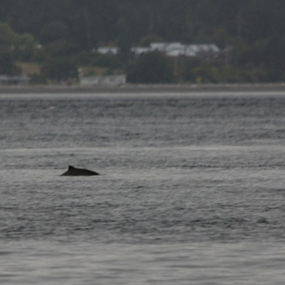 Although the harbor porpoise is the most abundant and widely dispersed cetacean species in the Salish Sea, we still know very little about its habitat needs, distribution, population trends, life cycle, genetics, behavior and role in the ecosystem.
Harbor porpoises feed primarily on fish and are among the smallest of the cetaceans, reaching an average size of about 5 feet and 120 pounds. They can dive deep, more than 655 feet, but usually stay near the surface, coming up regularly to breathe with a distinctive puffing noise that resembles a sneeze.
Although the harbor porpoise is the most abundant and widely dispersed cetacean species in the Salish Sea, we still know very little about its habitat needs, distribution, population trends, life cycle, genetics, behavior and role in the ecosystem.
Harbor porpoises feed primarily on fish and are among the smallest of the cetaceans, reaching an average size of about 5 feet and 120 pounds. They can dive deep, more than 655 feet, but usually stay near the surface, coming up regularly to breathe with a distinctive puffing noise that resembles a sneeze.
In the Salish Sea, harbor porpoises face a number of threats including pollution, noise, crowding, death due to bycatch, depleted stocks of forage fish, and habitat loss.
On February 7th, SeaDoc helped convene a US / Canadian workshop to bring scientists and managers together. This "think-tank," co-sponsored by the Pacific Biodiversity Institute and Cascadia Research Collective, identified areas where more data are needed to better understand and manage the population, including things like doing a population stock assessment that will tell us if their numbers have grown or declined since the last one was conducted a decade ago.
This workshop is a good example of how SeaDoc works to bring US and Canadian scientists together to improve our management of the ecosystem. It's a repeat performance on past successful SeaDoc "think tanks" focusing on rockfish, abalone and forage fish.
The meeting notes, including some consensus statements from the scientists involved, are available as a PDF. Click here to download.

